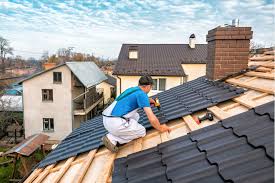Introduction
Metal roofing has become one of the most popular options for homeowners and businesses. Known for its durability, energy efficiency, and stylish appeal, metal roofing is an excellent alternative to traditional asphalt shingles. Whether you’re constructing a new home, renovating an old one, or upgrading a commercial property, understanding the benefits and features of metal roofing can help you make an informed decision.
Benefits of Metal Roofing
1. Durability and Longevity
One of the most significant advantages of metal roofing is its lifespan. Unlike asphalt shingles, which typically last 15–20 years, metal roofs can last 40–70 years, depending on the material. Metal roofs are resistant to harsh weather conditions, including heavy rain, snow, hail, and strong winds.
2. Energy Efficiency
Metal roofs reflect solar radiant heat, which helps reduce cooling costs in the summer. Many metal roofs have reflective coatings that further enhance their energy efficiency, making them an eco-friendly choice for homes and commercial buildings.
3. Environmentally Friendly
Most metal roofing materials are made from recycled content and are 100% recyclable at the end of their life. Unlike asphalt shingles, which contribute to landfill waste, metal roofing promotes sustainability.
4. Fire Resistance
Metal roofs have a Class A fire rating, the highest level of fire resistance available. This makes them an excellent choice for areas prone to wildfires or lightning strikes.
5. Low Maintenance
Metal roofs require minimal maintenance compared to other roofing materials. They do not rot, crack, or warp like wood or asphalt, and they resist mold and mildew growth.
6. Stylish and Versatile
Available in a variety of colors, finishes, and styles, metal roofing can complement any architectural design. Whether you prefer a modern, rustic, or traditional look, there is a metal roofing option to match your aesthetic preferences.
Types of Metal Roofing
1. Standing Seam Metal Roofing
This is one of the most common types of metal roofing. It features raised seams that run vertically along the roof, providing a sleek, modern look and excellent water resistance.
- Best for: Residential and commercial buildings
- Benefits: Superior weather resistance, long lifespan, and minimal maintenance
2. Corrugated Metal Roofing
Corrugated metal roofing is made of panels with a wavy pattern. It is lightweight, cost-effective, and often used for agricultural, industrial, and rustic-style homes.
- Best for: Barns, sheds, warehouses, and rustic homes
- Benefits: Affordable, durable, and easy to install
3. Metal Shingles and Tiles
Metal shingles mimic the look of traditional shingles, wood shakes, or tiles while offering the durability of metal.
- Best for: Homeowners who want the look of traditional shingles with added durability
- Benefits: Aesthetic appeal, long lifespan, and lightweight design
4. Stone-Coated Metal Roofing
Stone-coated metal roofing combines the durability of metal with the appearance of traditional roofing materials like clay tiles or wood shakes.
- Best for: Residential homes in extreme weather conditions
- Benefits: High impact resistance, aesthetic variety, and durability
Installation Process
The installation of a metal roof requires precision and expertise. Here’s an overview of the process:
- Preparation and Measurement – The roof structure is measured to determine the necessary materials and layout.
- Removing Old Roofing (if applicable) – If replacing an existing roof, old materials are removed to ensure a clean surface.
- Installing Underlayment – A protective layer is placed under the metal roofing to prevent moisture buildup.
- Laying the Metal Panels – Metal panels or shingles are installed from the bottom up, overlapping to prevent leaks.
- Sealing and Fastening – Seams and fasteners are sealed to ensure weather resistance and longevity.
- Final Inspection – A thorough check is done to confirm everything is securely in place and properly installed.
Maintenance Tips for Metal Roofing
Although metal roofs require little maintenance, following these simple steps will extend their lifespan:
- Inspect the Roof Annually – Check for loose fasteners, scratches, or debris accumulation.
- Clean the Roof Surface – Remove dirt, leaves, and debris to prevent water pooling.
- Check for Rust and Corrosion – If the roof is not galvanized, look for signs of rust and apply protective coatings as needed.
- Ensure Proper Drainage – Keep gutters and downspouts clear to prevent water buildup.
- Trim Overhanging Branches – Prevent damage from falling limbs or excessive shade causing mold growth.
Choosing the Right Metal Roofing for Your Needs
When selecting metal roofing, consider the following factors:
- Budget – Some materials, like copper, are more expensive than steel or aluminum.
- Climate – Choose a metal roof that suits your region’s weather conditions.
- Aesthetic Preferences – Select a style and color that complements your home or business.
- Longevity and Warranty – Invest in a product with a strong warranty and proven durability.
- Installation Costs – Consider whether professional installation is required or if it’s a DIY-friendly option.
Conclusion
Metal roofing is an excellent investment for those looking for a long-lasting, energy-efficient, and stylish roofing solution. With various types available, homeowners and businesses can find a metal roof that suits their needs and aesthetic preferences. Whether you’re replacing an old roof or installing a new one, metal roofing offers unmatched durability, environmental benefits, and cost savings in the long run.
